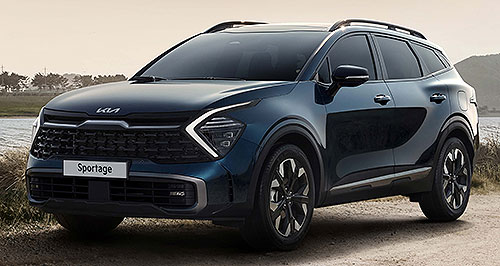News - Market Insight - Market Insight 2021Kia inches up the ladderSpotlight: Once in the shadow of its majority shareholder Hyundai, Kia has found fame and profit that even astounds Japanese auto royalty. From discount brand to high demand in barely a decade, Kia closes in on Hyundai26 Jul 2021 By NEIL DOWLING MY FATHER asked my opinion of the Kia Mentor following the sedan version’s launch in 1998, a year after the debut of the Mentor hatch and the first hint that Kia could either be a contender in the frenzied Australian new-car market or just a flash in the pan.
What the Mentor offered over the contemporary Toyota Corolla was insufficient to be worthy of my father’s money. Though the equipment level was better, and the dealer was willing to boost the trade-in price, the Mentor’s build quality was relatively poor and the styling was as bland as the Corolla.
He bought the Corolla. A lot of other people gave up on becoming Kia owners around the same time. Few would risk paying for a newcomer despite the strength of Australia’s biggest independent distributor, Ateco Automotive, behind the brand from 2000.
But despite the critics, Kia persisted in this hot-bed market, taking sales of 9888 in the full year of 2000 to 61,503 units in 2019, before COVID pricked every brand’s hopes and pared that back to 56,076 in 2020.
In 2000, Hyundai sold 45,331 units and one of Japan’s best in terms of quality and perception, Mazda, recorded 27,505 sales.
That year, Kia offered eight models with the Rio being the most popular, compared with Hyundai that had a similar number of models among which the Accent and outgoing Excel were its best sellers. Mazda had 12 models including the T-series truck and two Eunos cars, for 27,505 deliveries and the 323 as the dominant seller.
By 2010, Kia’s best seller in its 11-model line-up remained the Rio with the Carnival people mover a close second. Sales continued to climb through 23,000 in 2020 and past 25,000 in 2011, while at the same time Mazda scored almost 85,000 units in 2010 and the Mazda3 was by far and away the leader.
Hyundai achieved 80,038 sales in 2010, so was the stronger of the trio with expectations that that trend would continue. But by 2012, Mazda had overtaken Hyundai – a position that remains unchallenged to this day.
The reason for Mazda’s leap was the CX-5. Although the company had the CX-7 as its family-oriented SUV, it was the styling of the all-new wagon and the better balance of engine performance and economy – a weak point of the CX-7 – that brought in buyers.
It was aided by the strong uptake of SUVs in 2012, also benefitting Kia that saw its Sportage small SUV start to gain sales traction alongside the bigger Sorento, as did Hyundai with the ix35 and Santa Fe.
The big impact of SUVs pushed Hyundai sales up strongly in 2016 to 101,555 units for the year, prompted by the success of the Tucson medium SUV that was introduced late in 2015.
Tucson quadrupled its 2015 sales in 2016, propelling the SUV from seventh best-seller in 2015 to second-best a year later, beaten only by the i30 hatch.
Sales of the Tucson’s equivalent, the Sportage, jumped 43 per cent in the same period as the brand recorded a total of 42,668 units for 2016, up 26.5 per cent on 2015.
Mazda, meanwhile, had only a modest 3.7 per cent rise in the period that set the Koreans alight. This was surprising given it had previously introduced the CX-3 and had a strong trio of SUVs – with the CX-5 and seven-seat CX-9 – for buyers.
Some attention was diverted by the SUVs from the previous hot-selling Mazda3, while the sedan market was declining and diminished sales for the Mazda6 while Mazda now had eight models to choose from, which was fewer than in previous years.
From 2016, both Mazda and Hyundai sales began to taper while Kia sales rose.
Mazda added another SUV, the (then) diesel-only CX-8 in 2018 but sales for the year dropped 4.4 per cent. Hyundai also fell, down 2.9 per cent in line with the industry slide of 3.0 per cent, despite adding the Kona small SUV.
Kia surprised its peers. It thought outside the SUV square and added the Picanto city car and rear-drive Stinger sedan – both unlikely to succeed based on previous trends – and maintained its two-pronged SUV range to record a 7.5 per cent growth for the year.
In 2020, the annus horribilis, all manufacturers were hit by the effects of the pandemic, striking consumer confidence, factory production, shipping and retailing.
Kia fell 8.8 per cent that year; Hyundai was down 24.7 per cent and Mazda lost 12.3 per cent over its 2019 result.
Despite the falls, new models were introduced in 2019 and 2020 including Hyundai’s i30 sedan update, the Palisade large SUV and the Venue small SUV; Mazda launched the CX-30 and Kia the Seltos small SUV that started kicking goals in 2019.
Now 2021 is changing the trendline. In the six months to June 2021, Mazda has made big sales advances and has sold 60,446 units, up 36 per cent on the same time in 2020.
Hyundai is up 20 per cent in the six months compared with the previous year, with 38,634 sales to date; and Kia has sold 37,894 vehicles, up 30 per cent and for the first time, is challenging its major shareholder, Hyundai. It will be an interesting year.  |
Click to shareMarket Insight articlesResearch Market Insight Motor industry news |
















Facebook Twitter Instagram